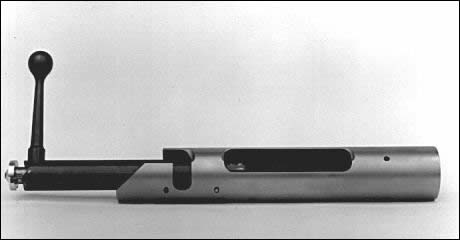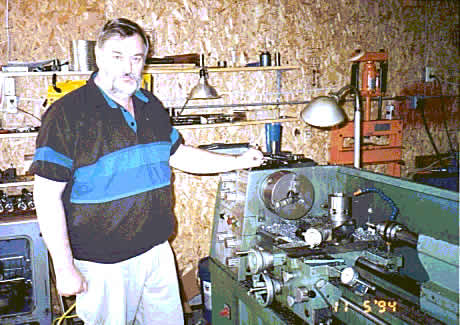The Geske Action
January 23, 2015 2:28 amGerry Geske was born in Saskatchewan, Canada farm country. An area that’s home to big whitetail deer, too. Perhaps it was while pursuing those big bucks that Gerry developed his fascination with rifles. Leaving Canada, Gerry put himself through college in North Dakota by working for the railroad at night. There are probably a few better ways to enjoy a cold winter, but Gerry looks back fondly on those days now.
Today Gerry lives in the small mountain town of Superior, Montana, where he works as a School District Psychologist. With retirement getting closer, Gerry decided to look into manufacturing rifle actions as both an interesting diversion and a possible source of retirement income.
Prior to getting involved in producing custom actions, Gerry spent his summers flying his own crop duster in the wheat country of eastern Montana. Perhaps age or wisdom prompted him to give up that avocation, and the airplane was exchanged for a shop full of machine tools.
One of Gerry’s interests is long-range hunting, especially for big whitetails. He decided that his action would be one suited primarily for the big magnum cartridges used for long, cross-canyon shots. He states that his desire is to offer a high grade action designed for 1000 yard target work and long-range hunting rifles. Gerry has, in my opinion, answered that call on both fronts quite well. Let’s look now at the action and see how it is designed and built.
Gerry chose a precipitation-type hardening stainless steel, 17-4, in manufacturing his single-shot receiver. The action begins as a 1-9/16″ diameter bar, about 10″ long. The first operation in machining the receiver is gun-drilling the bolt hole. Gerry designed his gun-drilling system on a lathe, and it has worked well for him. After drilling, the hole is honed to final size and finish. The outside of the receiver is then trued-up with the hole.
The next step in producing the receiver involves machining the barrel threads in the front end. This operation is greatly simplified by virtue of the receiver being round. This allows the use of standard tooling and lathe chucks. Gerry does all of his machining with conventional-type machine tools, although he does “farm” out a few parts to a friend’s CNC shop.
Other machine work on the receiver includes milling of the tang and port. On the side opposite the port, Gerry has milled a neat, scalloped cut, matching the size of the loading port. Then the Geske name and serial number is nicely engraved onto the milled panel. The action is given an attractive bead blasted finish. They are available with either left or right hand bolts and loading ports.
The final machined size of the action is 1.54″ in diameter and 9.20″ in length. The port opening is 3.60″ long, but with the bolt fully retracted, a shell up to about 4.2″ long can be extracted. The action, less trigger, weighs 52 ounces. Gerry offers as an option, a big Remington style recoil lug. His rationale is; guns using a barrel bedding block won’t require a lug.
The action is tapped for 8-40 scope base screws on the top side, and conventional 1/4-28 guard screw holes on the bottom. The receiver is also machined to accept a Remington-type trigger. Unlike many custom actions, the trigger is held in place with two cross pins, like a Remington receiver. I like separate trigger hangers, but the lack of one is not a major loss.
In part, due to the difficulty in machining long raceways in the receiver, Gerry elected to use a full diameter bolt. This means that the .890″ diameter bolt body is the same diameter as the lugs. This is a common approach to solving this problem. Less common, though, is the employment of three locking lugs.
With an action designed to handle big magnum cases, like the 378 Weatherby or the similar 416 Rigby, a lot of bolt thrust is generated. From the earlier article describing the mechanics of bolt lug shear strength and bolt thrust, we learned that one of the simplest things an action designer can do to increase overall bolt lug strength, is to increase the number of lugs.
Gerry has done this, and as we will see from the strength and bolt lug flex numbers, he has achieved his goal. If we use the 378 Weatherby cartridge as an example in calculating bolt lug shear strength, bolt thrust and bolt flex numbers, we can see just how strong the Geske action is. Using a simulated chamber pressure of 65,000 PSI, we find that the amount of bolt thrust generated by the big case is about 12,760 pounds. To resist this, the bolt lug shear strength is 72,620 pounds and the amount of bolt flex is .0015″. To get an idea of how strong these lugs are, a Remington 700 bolt would offer just slightly more than half the shear strength of the Geske, at 37,480 pounds. Though I wouldn’t recommend it, if we put a .378 Weatherby barrel on a Remington, the amount of bolt flex would be .0026″. Gerry also believes that three lugs provide a more stable bolt face. One less subject to vibrational effects than a two lug design.
The bolt is machined from 4140 and heat treated to a hardness of about 45 Rockwell “C”. The bolt is a close fit in the receiver, and combined with the dual cocking cams, bolt operation is very smooth.
Another interesting feature of the Geske action is the design of the internal locking lug abutments. Partly because the Geske action has a long barrel thread tenon– 1.30″ long–machining lug abutments and internal closing cams could be difficult. Gerry’s solution to this: make the abutments a separate part threaded into the front of the receiver, much as a barrel is. Gerry’s approach is similar to the Voere action, but more refined. Whereas the Voere K- 14 has a pressed-in insert, the Geske is threaded and pinned. When he threads the front end of the receivers, the thread is run in farther than normal. The insert has an external thread with the same pitch and after a little locktight is applied, the two become one. The two parts are then pinned as a safety margin. The barrel thread diameter is 1.125″ by 16 TPI.
An advantage to this system is the ability to closely control the heat treating of this critical part, without causing distortion or overhardening of the entire receiver. Also, the portion of the insert that comes into contact with the lugs can be finish ground on a surface grinder after heat treatment. Try that with a conventional locking arrangement! After final fitting, the lugs are lapped into place too. Gerry machines the bolt closing cam onto both the locking lug insert and the bolt lugs.
The bolt handle also serves as the cam follower on the opening cam. Because of the three-lug design, bolt rotation is just 65 degrees. The Sako-type extractor does its job well. With a 338/378 Weatherby barrel on a Geske action, I’ve had to tap the bolt back with a plastic hammer to extract very tired brass. The problems lies with the web and belt design of the 378 cases, not the action. The point is, the extractor pulled the cases out of the chamber without jumping over the rim. An ejector is also standard equipment and it can be easily deactivated.
Although most of his bolt heads are machined for either the standard magnum head size or for the big 378 Weatherby cases, Gerry will make them for 30/06 size cases too. The bolt nose has a 120 degree included angle cone as an aid in feeding.
In the event of a case or primer rupture, gas is controlled through two opposing holes in the receiver, just behind the barrel thread shank, and via three holes in the bolt body, port side.
I have been using a Geske action on a long-range hunting rifle. At present I use a 40″ long 338-416 Rigby barrel on this action. That long barrel is just hanging from the receiver threads, and I’ve been surprised at how well it has performed. I would usually suggest a barrel block for a barrel that long, but decided not to block this one. The stock bedding has remained true and I can’t detect any flexing of the receiver. The minimum-size loading port obviously increases the cross-sectional area, and in return, stiffness.

As an aside, I first had a 46″ long 1.25″ diameter barrel on this receiver, chambered for the 338/378 Weatherby. As a velocity check experiment I cut two inches at a time from this gangly barrel until I was down to a stubby 24 inches. The bedding and receiver held up fine.
My wife and I used this rifle antelope hunting during the 1994 season. We enjoyed the hunting and, with the aid of a good rangefinder and 300 grain Sierra Match Kings, shot some antelope at extended distances. (The fact that her buck was considerably bigger than mine should not reflect badly towards the action.) I used this same combination on an Idaho rock chuck hunt, shooting some chucks out to 1000 yards or so.
I mentioned that one of Gerry’s goals was to offer an action suitable for long-range target work, too. The Geske action has been used by over half a dozen competitors at the Williamsport 1000 yard club, and has shown up in the equipment lists of the winners there. When I visited the club in the summer of 1993, one of the competitors mentioned to me that he felt the Geske was one of the very best actions available for building their highly specialized 1000 yard rifles.
Overall, I would give the Geske action high marks in several areas. I like the choice of materials and the overall design of the receiver reeks of stiffness (essential to accuracy). His approach in designing and building the locking lug abutment insert is rather novel and ingenious at the same time. The three locking lugs add measurably to the strength of the bolt as compared to some two-lug designs. The dual cocking pieces are neat, probably add to the smooth cocking with a stiff mainspring, but are unnecessary, too. I like to see at least a 1.125″ diameter barrel thread, like the Geske has, for receivers that will handle the 378 Weatherby cases. The firing pin is machined from titanium, allowing for quick lock-time. Threading the bolt handle into the bolt is nother plus. Breaking off a handle with this action will never be a problem. Also, using #8 screws for the scope bases is a good idea for any rifle that is chambered for the big 378 Weatherby/416 Rigby cases.
There are a few things, though, that I would probably change on the Geske action. Although it looks nice and adds to stiffness, I’d like to see the size of the loading port increased a little. There is not a lot of room to reach in and remove a case. This is especially true when hunting in colder weather. Usually fingers are cold and stiff, or gloved while glassing for game. Also, the tang needs a little refinement from a cosmetic standpoint, in my opinion. The bolt shroud looks almost like an after thought. It’s a small, dainty little aluminum button. I’d like to see a bigger shroud, contoured to the shape of the tang. The present bolt handle is a little too long and skinny for my tastes. Gerry does though offer as an option his original, stockier handle.
As the saying goes though, “form follows function”. The many satisfied long-range hunters around the country and the competitors at Williamsport using this action will testify that the Geske does perform and function well–very well. And I guess that’s what precision shooting is all about.
For more information contact:
Gerry Geske
P.O. Box 517
Superior, Montana 59872
406-822-4917


